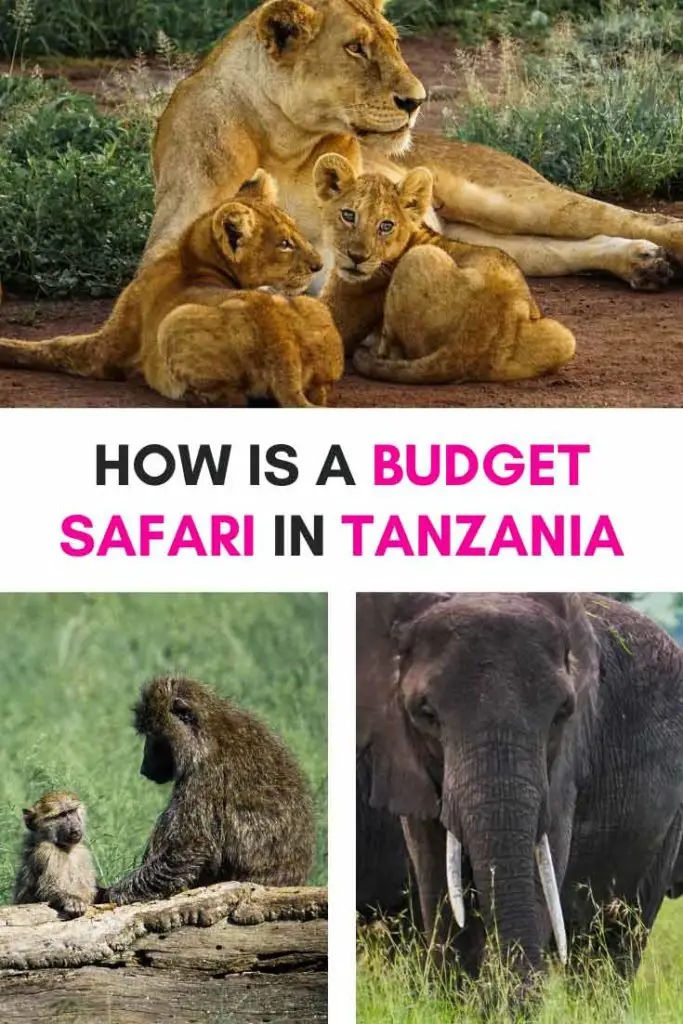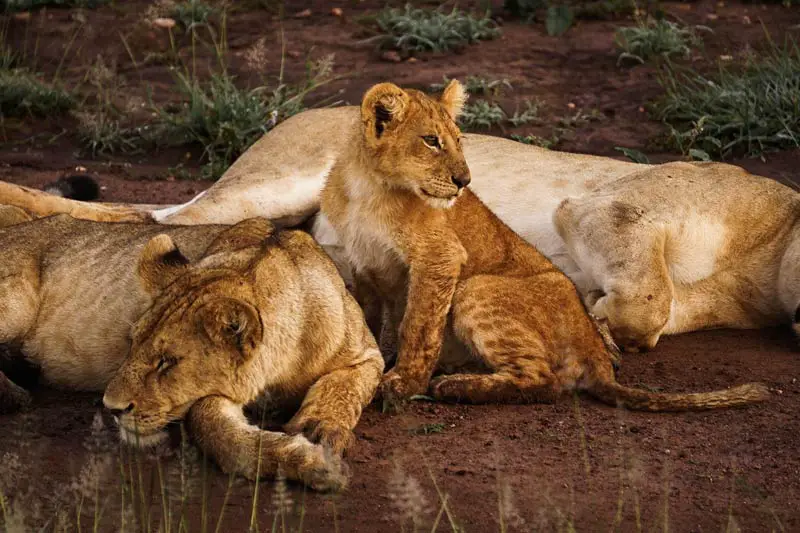Going on a safari in Tanzania is one of those experiences that will probably only happen once in a lifetime. You’ve booked your flight to Tanzania, you’ve researched the great destinations you want to visit in the country, and now it’s time to choose a safari. But oh my, the shock comes when you see how much a safari in Tanzania actually costs. More than the flight, probably more than the entire trip. There are different options for Tanzanian safaris: budget, mid-range and luxury.
If you have a limited amount to spend on activities, then a budget safari in Tanzania offers that memorable experience you are looking for, but without the frills. Sure, overnight stays in luxury lodges, with private swimming pools and your own private butler, sound fantastic but hey, to afford such an experience, we would all have to be millionaires.
What is a Budget Safari?

A budget safari in Tanzania is still a fantastic and authentic experience of getting close to the animals in their natural habitat. Don’t let the word “budget” put you off when researching for that perfect trip in Tanzania. Choosing a budget safari doesn’t mean at all that you will see less animals, or receive a lower quality service. From my own experience, our guide went above and beyond to ensure that we saw all the big five, which we did. As an experienced guide, he chose routes less populated, which made our experience more personal. You will be surprised on how crowded Serengeti National Park is, even in low season!
One of the things that defines a budget safari in Tanzania is that you will be sharing the car with other travellers. On a luxury safari, you will have your own driver and vehicle. When choosing the budget option, you can expect other excited safari goers to join you. A jeep has 6 seats, so there are never more than six people in one car.

When it comes to accommodation, on a budget safari you will be sleeping in a tent, in a camp. Depending on which company you are travelling with, the camps can be inside or outside the national parks. To be honest, sleeping in a tent in the middle of the savanna is quite special. During my budget safari in Serengeti National Park, we had wild animals visiting the camps every night. It’s quite special to hear the roaring of the lions so close to you, to hear the hyenas trying to get into the bins at night, or almost feel the breath of the zebras grazing just outside the tent. You don’t really get that in a luxury resort.
When it comes to an itinerary, when you book a budget safari, you have a set itinerary that you can’t alter. On a luxury safari you can decide where you want to go and how long you want to stay in one place. Also, on a basic safari you will lose time on the road, as driving from Arusha or Moshi to Serengeti takes almost the entire day. On a luxury safari you will usually fly directly to Serengeti National Park, which has an airstrip for small aircraft.
What Safari Itinerary to Choose in Tanzania?

After experiencing a little bit of the wildlife of Tanzania, I can recommend that you do your research before you book a safari. Distances between the parks are quite long and, just to give you an example, it will take the entire day to reach Serengeti National Park from Moshi. When a safari tour is advertised as 4 days, once you deduct the travelling time, this leaves 2.5 days.
I went on a 4 days safari to Serengeti National Park and Ngorongoro Crater. Whilst the first day was mostly driving, we did get a very close encounter with a herd of elephants, just before reaching our camp. If you want to visit Tarangire National Park, which is famous for elephants, or Manyara Lake, which is famous for tree climbing lions, you will need to add at least two extra days to your itinerary.
No matter which itinerary you choose, you should not skip Ngorongoro Crater. This is the most likely place to spot rhinos! I saw 8 during my safari!

Most of the safari tours are in the North of the country. However, if you are on a very tight budget and have limited time, you might consider going on a safari in the South of the country. These tend to be cheaper and less touristy.
Serengeti is the most popular national park in Tanzania, stretching a distance of 14,750 square meters. It is famous for the annual migration of wildebeest and zebras, when hundreds of thousands of animals move from north to south and back searching for water and fresh grazing fields. Some of the other animals that you will see in Serengeti National Park include lions, cheetahs, leopards, elephants, giraffes and hippos.
Ngorongoro Conservation Area is a must on any safari itinerary in Tanzania and is the place where you will have most chances to spot the big five in one single day. The crater was formed two to three million years ago, when a volcano collapsed on itself. It is the world’s largest inactive volcanic caldera, 610 meters deep. This is where you will most likely be able to spot black rhinos, as there are around 60 living inside the crater. Other animals that you can see in Ngorongoro Conservation area include African buffalos, hippos, lions, hyenas, blue monkeys and flamingos.

Tarangire National Park is famous for its elephant herds that roam around tall baobab trees. The sixth largest national park in Tanzania, Tarangire is a great destination for bird lovers as well, having the largest population of breeding species of birds on the planet. Some of the other animals found in Tarangire include leopards, cheetahs, ostriches, monkeys, pythons and impalas.
Lake Manyara National Park is often included as a half a day stop on safari itineraries. Seen from above, Lake Manyara looks pink, and that is because of the thousands of hundreds of flamingos living here. The lions living in Lake Manyara National Park are called tree climbers because they like to spend a lot of time sleeping on branches, 5-6 meters above the ground. It is not clear why the lions like to climb trees and spend so much time at this height. Other animals seen in Manyara National Park are baboons, giraffes, zebras, warthogs, and waterbucks.
Selous Game Reserve is a great budget alternative for people who are travelling to Dar es Salaam and want to have a safari experience. Located in the south of the country, Selous Game Reserve is an Unesco heritage site because of its wildlife diversity and untouched nature. Some of the animals that you can see here are the Nile crocodile, the East African wild dog, the African Bush elephant and the Masai giraffe.
What Does a Budget Safari Include?

A budget safari includes the same things as a luxury one, the difference is just in accommodation, number of people and freedom in choosing your own itinerary, as explained above.
A budget safari will include the following:
- 4×4 transport
- Basic accommodation in camps
- 3 meals a day
- A guide and a cook
- All the park fees
- Bottled water
How is the Jeep on a Budget Safari in Tanzania?

This is a tricky question to answer because even if most safari companies are using the same type of Landcruiser vehicle for the safaris, some are in better shape than others. You need to do a good research to decide which would be the best company to go on a safari with. No matter if you are on a budget or luxury safari, the vehicles should offer the same comfort and safety. The only jeeps are that different belong to the very expensive resorts in the National Parks, and those open up completely allowing a 360 view (and feel).
I went on my safari with African Scenic Safaris and the vehicle we were in was comfortable and modern, with a charger and a fridge in the back. The roof of the jeep popped up so we could see the animals better, and there were handlebars all around the roof to hold on to whilst the vehicle was in motion.
I went on a safari during the rainy season, and many of the trails were flooded. I have seen so many jeeps stuck in the mud because they had an older manual 4WD system, or because the drivers weren’t as experienced. We stopped quite a few times so our guide could help them, and we even towed a couple out of the mud. Our Jimmy was the hero for many groups that day.
How are the Camps on a Budget Safari?

The camp accommodation on a budget safari is quite comfortable. Different companies have different types of tents, some of them even have beds. My tent was quite big, meaning that I could stand up inside it. It has windows as well as a rain cover, which was very useful in Ngorongoro, where it rained the entire night. The bed was a mattress on the floor, which was surprisingly quite comfortable. The safari company I went with, African Scenic Safaris, provided us with warm sleeping bags as well, which were a blessing in Ngorongoro, where it was cold.
The camps are quite basic but very clean. The toilets and showers are shared but they are kept clean. Some of the camps even have hot water!
You need to know that electricity is provided through solar panels and might not always work. My strategy was to charge my power bank in the car, during the day, and then use it during the night to charge my phone and my camera. This way I didn’t have to use the electricity in the camp.
You might also wander if it’s safe to go to the toilet during the night, when camping. Honestly, I would not recommend it. We had hyenas “laughing” at 2am in the morning just outside the tent. We were advised that if we do need to go to the toilet in the middle of the night, to slightly open the tent and move a flashlight around for a couple of minutes. Animals don’t like powerful light sources. However, my advice would be to just not drink too much beer for dinner, so you don’t need to worry about lions chasing you on your way to the toilet. 😊
How is the Food on a Budget Safari?

When you go on a budget safari, you will be accompanied by a guide and a cook. Whilst you are out exploring the national parks, the cook will not only prepare the food, but he will also set up the tents and the tables.
You would be surprised on how delicious the food is during a budget safari. We always had at least four different dishes and dessert for each meal. In the morning, the cook wakes up at least one hour before everybody else and starts preparing breakfast: eggs, pancakes, toast, tea and coffee.
For lunch, depending on how far in the national parks you go, you either have the food packed in a to-go box, or return to the camp. Our meal boxes were impressive, with roasted chicken, boiled eggs, sandwiches, juice boxes and even muffins for dessert. There was always a fruit inside the box too. Our second lunch in nature was at the picnic spot from the hippo pool, in Serengeti, for which our cook made rice and beef stew which he packed in thermal pots. He packed them in the car in the morning, and they kept hot until lunch time.
For dinner we always had a feast. Besides traditional Tanzanian dishes such as ugali, pilau rice and beef stew, we also had pizza, French fries, and spaghetti bolognese. Each dinner started with soup and finished with dessert. We even had banana fritters with chocolate sauce and cake.
There is always plenty of food for everyone, our group of six always had leftovers.
Can You Buy Extra Food or Drinks on a Budget Safari?

The answer is yes, you can buy extra food and drinks during a budget safari, as there is a little local shop somewhere around Seronera Airstrip. However, before the safari starts, the jeep will stop at a supermarket in Arusha, where you can buy all you need for the trip, including beer, crisps, or biscuits. Or a cheeky bottle of Konyac, one of the most popular alcoholic drink in Tanzania.
The shop in Serengeti National Park is not a usual stop on a budget safari, we only went there to get some batteries which were needed for the camp, so my advice would be to do all your shopping beforehand at the supermarket in Arusha.
How Much Does a Budget Safari in Tanzania cost?

Unfortunately, this is a very hard question to answer, because each company has its own prices and they never advertise so you need to enquire. The price of a budget safari depends on how many people will be joining (as a rule – the more people join, the better the price is), and of the itinerary chosen. I would say that a round figure for a 4 days / 3 nights safari would be somewhere around $1000. Some National Parks are cheaper than others, so if for example you choose to go to Tarangire instead of Ngorongoro, the price would be lower, as the latter has the most expensive fees in Tanzania. Remember that you will also have to tip your guide and cook. The tip for a guide is around 30-40 dollars a day, whilst for the cook is around 15-20 dollars a day, split between everyone in the vehicle.
Like it? Pin it!

Disclaimer: Please note that I received a discount for my safari experience from African Scenic Safaris, as a Christmas trip with the volunteers from Hostel Hoff, under no contract to write about it. All the opinions in this article are my own and I would not recommend anything that I wouldn’t have enjoyed myself doing or think it was a great place to visit.
Some of the links on this website are “affiliate links.” This means that if you click on the link and do a purchase, I will receive an affiliate commission at no extra cost for you. This helps me keep my website running and continue to share my traveling knowledge with you. I thank you for booking your flights or hotels using the links on my website. Regardless, I only recommend products or services I use personally and believe will add value to my readers.





safari adventure is one of my dream experience,,,#1 on my bucket list. cant imagine my self be with this nature in a safeway. elephants,lions ,hyenas,wow its a like a dream come true
This is a life changing experience. Visiting a safari is really awesome.I would love to be there to.
Very interesting experience. Although I’ve never had a safari experience before, I would love to go to one in the future!
This is such a helpful post. Going to safari is one of my biggest wishes. I really hope that one day I will manage to achieve it.
I could easily cope sharing to help make the safari a budget safari. It sounds like an awesome thing to do.
This is amazing and something I did when I was younger, but would love to do as an adult. Your pictures of the animals are amazing xx
I have read so many luxury styled safari holidays which are beyond my budget so never really thought I could travel on one. Reading your post a budget safari sounds equally enjoyable but don’t break the bank at the same time.
I have always wanted to go on a safari. Being that I’m always looking for ways to save money this budget safari looks right up my alley.
what a wonderful experience, it’s good to read about all the different areas for a safari – I’d love to go on a safari one day… noted about nighttime toilet trips. that made me smile.